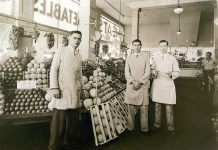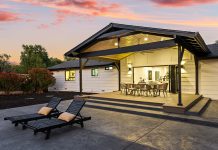History. Tradition. Ancestry. It just doesn’t get much richer,
but where do I begin? I’m interviewing fifteen women who are
recounting the last 100 years of the organization. So we have
personal stories, group history and memories a plenty of this
beautiful valley.
My friend and fellow historian, Ann Howard, has invited me to
attend a meeting of the Centennial Celebration of the Dry Creek
Neighbors Club, held at the home of Theresa Wistrom, with a
presentation by Kay Robinson and Ann Howard (current club
president). Also in attendance are April Bennett Lance, Charlotte
Chavez, Lois Bohn, Sharon Pillsbury, Mary Jane Corson, Clyda Ritz,
Bev Pillsbury, Nadine Anderson, Bertha Carley, Anne Rued, Mary Jo
Garrett and Charlotte Damkroger — all Dry Creek neighbors who
comprise almost half of the membership. Clyda joined 51 years ago.
Charlotte is a brand new member.
Marilyn Johnson’s grandfather’s bell brings the meeting to
order. These women are so historically astute that a discussion
immediately ensures as to whether the bell belonged to the same
grandfather who owned a certain jeweled walking cane which was once
sold for $75,000. Kay and Ann then share some fascinating
historical tidbits with the group.
The club (originally the Dry Creek Woman’s Home Mission Society)
was organized in 1909 when a small group of women met at the home
of Mrs. James (Elizabeth) Hendricks at 7005 Dry Creek Road. The
dues were originally 10¢ per meeting. The motto “Kind Thoughts,
Kind Words, Kind Deeds” was chosen. Women read the Bible and sang
hymns at each meeting as well as making quilts for the children at
the local Salvation Army Home and other charities. The club once
donated $10.00 to help dig a well for a local family and gave
$21.00 to a sick man. Members volunteered and donated to the Red
Cross during both world wars when they had to keep their budget
tight.
In 1926 the club purchased three dozen serving trays which have
been repainted many times over and are still passed among the
members, along with a coffee pot, for refreshments at the monthly
meetings. In 1930 dues were raised to 90¢ and the club had $24.11
cash on hand. Membership has remained at 30 to 35 women who must
live within the watershed of Dry Creek Valley. Beginning in 1949
the club began a scholarship fund which is awarded each year to
graduating seniors of Healdsburg and Geyserville High Schools. By
2008 the total money given as scholarships added up to $32,500!
The ladies want me to know what they are best known for: their
fudge. In 1999 they received a “thank you” for 50 years as the
longest running participant (60 years now) in the Healdsburg Future
Farmers Country Fair where they sell the candy.
“We’re the fudge ladies!” they echo in chorus.
“Our biggest job is making fudge for the fair each year,” April
fills me in. “We meet in a hall and pack all our combined fudge
candies in half pound red and white checkered boxes with red, white
and blue ribbons. We sell them too inexpensively because people
rush the booth and we sell out quickly.”
“We used to weigh the candy in our old pink booth and they’d
select by the piece,” Clyda adds. “But now it’s strictly ‘nuts or
no nuts.’ We sold $80 worth our first year and last year we made
$2,677 by selling 600 half pound boxes.”
“It rained the year I joined,” Mary Jo recalls. “I remember Bev
Pillsbury and Louise Madden putting a plastic cover over the booth
in the middle of the night!”
The fudge money and what they make from their yearly corn beef
and cabbage St. Patrick’s Day dinner for the Geyserville Chamber of
Commerce all goes to high school scholarships.
In honor of the 1976 Bicentennial, club members spent three
years working on a collection of stories entitled “Vintage
Memories: Dry Creek, Neighbors and Friends”. The cover picture of
Manzanita School was sketched by local artist Rosinda Holmes and
the 750 copies at $4.00 each sold out quickly. Thank goodness the
Healdsburg Museum has one of these historical gems.
In 1975 and 1976 each member took part in creating an
autographed, personal quilt square and two quilts were raffled off
within the membership. The assignment was to pick a subject from
the valley and create your own design. Now all of us are “oohing
and aahing” over these sentimental works of art.
Clyda’s square reads, “Friendship: the older it grows, the
stronger it gets.” Another square depicts Mrs. Hendricks’ little
house where the group first formed in 1909. Marilyn Johnson has
made a flower out of the wool of her own sheep. Bertha Carley’s
shows a doberman (she raised them) in the center surrounded by her
sheep and goats, her two daughters, spinning wool and a horse in
the four corners. Someone mentions that Bertha is a story in
herself—she sold eggs to men living in trailers while they built
the Warm Springs Dam.
There is tradition here. Kay Robinson’s roots go back to D.D.
Phillips, the first European white settler (1856) to own the Pina
Adobe in Dry Creek Valley. Kay’s mother and both grandmothers —
Marie Phillips and Leila Schmidt—were all past club presidents, and
Kay had to carry on the torch as club secretary (historian). Lee
Nalle’s grandmother, Ruby Henderlong, was a member. Now Lee and her
hubby, Doug, own Grandma’s old prune ranch and have developed Nalle
Winery on property that has been in the family since 1927. April
Bennett Lance’s ancestors ran a mill in Mill Creek and a general
store on Center Street in town. Her grandfather built Dry Creek
Bridge and April recalls riding her horse to Dry Creek Valley every
day as a child.
And roots have been planted. Clyda states, “We were new when we
moved here in 1956 and this place has given me roots.”
Charlotte Damkroger, who moved here in 1970, just retired after
20 years with the Healdsburg Hospital Volunteers. Since her husband
died, she has had time to get to know her neighbors.
And Mary Jo Garrett says: “I met Anne Rued through a neighbor. I
was a child of the Depression, moving every three months, and
really needed roots. And I’ve found them here.”
Neighbors Lois Bohn and Nadine Anderson both attended Iowa
State, but only found each other here in Dry Creek Valley. Lois
tells me that she has never been a joiner — that was up until she
found “the most wonderful group in the world.”
Shonnie Brown is a Marriage and Family Therapist who is
interested in fostering connections between people and their
community. Shonnie also writes personal and family histories
through her business, Sonoma LifeStories. She can be reached by
e-mail at sh*****@***ic.net
or on the web at www.sonomalifestories.com.








